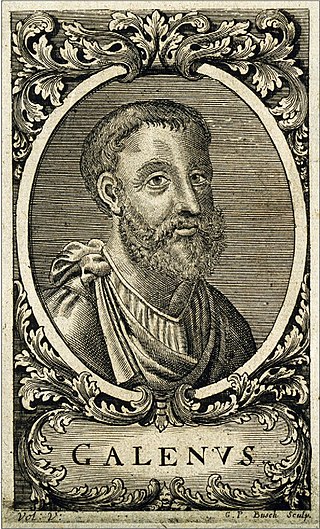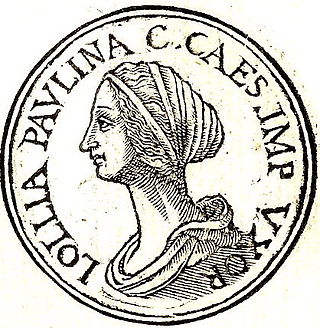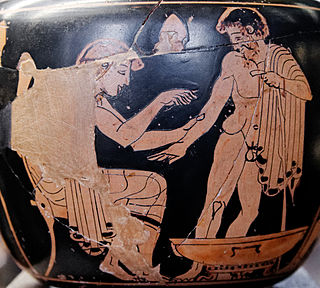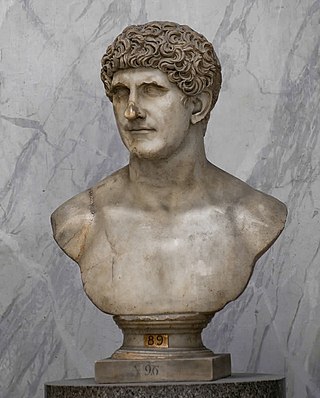Related Research Articles

Aelius Galenus or Claudius Galenus, often anglicized as Galen or Galen of Pergamon, was a Roman and Greek physician, surgeon, and philosopher. Considered to be one of the most accomplished of all medical researchers of antiquity, Galen influenced the development of various scientific disciplines, including anatomy, physiology, pathology, pharmacology, and neurology, as well as philosophy and logic.

Gaius Plinius Secundus, called Pliny the Elder, was a Roman author, naturalist, natural philosopher, naval and army commander of the early Roman Empire, and a friend of the emperor Vespasian. He wrote the encyclopedic Naturalis Historia, a comprehensive thirty-seven-volume work covering a vast array of topics on human knowledge and the natural world, which became an editorial model for encyclopedias. He spent most of his spare time studying, writing, and investigating natural and geographic phenomena in the field.

Gaius Caesar was a grandson and heir to the throne of Roman emperor Augustus, alongside his younger brother Lucius Caesar. Although he was born to Marcus Vipsanius Agrippa and Julia, Augustus' only daughter, Gaius and Lucius were raised by their grandfather as his adopted sons and joint-heirs. He experienced an accelerated political career befitting a member of the Julio-Claudian dynasty, with the Roman Senate allowing him to advance his career without first holding a quaestorship or praetorship, offices that ordinary senators were required to hold as part of the cursus honorum.

Erasistratus was a Greek anatomist and royal physician under Seleucus I Nicator of Syria. Along with fellow physician Herophilus, he founded a school of anatomy in Alexandria, where they carried out anatomical research. As well, he is credited with helping to found the methodic school of teachings of medicine in Alexandria whilst opposing traditional humoral theories of Hippocratic ideologies. Together with Herophilus, he is credited by historians as the potential founder of neuroscience due to his acknowledgements of nerves and their roles in motor control through the brain and skeletal muscles.
Elephantis was a Greek poet and physician renowned in the classical world as the author of a notorious sex manual. Due to the popularity of courtesans taking animal names in classical times, it is likely Elephantis is two or more persons of the same name. None of her works have survived, though they are referenced in other ancient texts.

Lollia Paulina was a Roman empress for six months in 38 as the third wife of the Roman emperor Caligula.

Asclepiades, sometimes called Asclepiades of Bithynia or Asclepiades of Prusa, was a Greek physician born at Prusias-on-Sea in Bithynia in Anatolia and who flourished at Rome, where he practised and taught Greek medicine. He attempted to build a new theory of disease, based on the flow of "atoms" through pores in the body. His treatments sought to restore harmony through the use of diet, exercise, and bathing.

Ancient Greek medicine was a compilation of theories and practices that were constantly expanding through new ideologies and trials. The Greek term for medicine was iatrikē. Many components were considered in ancient Greek medicine, intertwining the spiritual with the physical. Specifically, the ancient Greeks believed health was affected by the humors, geographic location, social class, diet, trauma, beliefs, and mindset. Early on the ancient Greeks believed that illnesses were "divine punishments" and that healing was a "gift from the Gods". As trials continued wherein theories were tested against symptoms and results, the pure spiritual beliefs regarding "punishments" and "gifts" were replaced with a foundation based in the physical, i.e., cause and effect.

The Medical community as used in this article refers to medical institutions and services offered to populations under the jurisdiction of the late Roman Republic and the Roman Empire. The Medical services of the Roman Republic and the early Roman Empire were adopted from ancient Greece. It was first imported from Greece through Greek colonies in Magna Graecia and the Etruscan civilization. After the Roman conquest of Greece, enslaved Greeks brought more Greek medical knowledge to Rome. In 219 BCE a surgeon named Archagathus traveled from the Peloponnesus to Rome. He became a citizen and purchased a taberna near a crossroads. This became the first officina medica. Previously, the pater familias was responsible for the medical art in early Rome. Physicians in ancient Rome would take the Hippocratic Oath. Doctors would begin their appointments with patients by stating "si vales valeo," which translated to "if you are well I am well." Physicians were often wealthy. Augustus' physician, Antonius Musa, received a salary of 30,000 sesterces. Doctors would also serve in the Roman military and treat injured soldiers.

Soranus of Ephesus was a Greek physician. He was born in Ephesus but practiced in Alexandria and subsequently in Rome, and was one of the chief representatives of the Methodic school of medicine. Several of his writings still survive, most notably his four-volume treatise on gynecology, and a Latin translation of his On Acute and Chronic Diseases.

Medicine in ancient Rome was highly influenced by ancient Greek medicine, but also developed new practices through knowledge of the Hippocratic Corpus combined with use of the treatment of diet, regimen, along with surgical procedures. This was most notably seen through the works of two of the prominent Greek physicians, Dioscorides and Galen, who practiced medicine and recorded their discoveries. This is contrary to two other physicians like Soranus of Ephesus and Asclepiades of Bithynia, who practiced medicine both in outside territories and in ancient Roman territory, subsequently. Dioscorides was a Roman army physician, Soranus was a representative for the Methodic school of medicine, Galen performed public demonstrations, and Asclepiades was a leading Roman physician. These four physicians all had knowledge of medicine, ailments, and treatments that were healing, long lasting and influential to human history.
Albucius or Albutius was a physician of ancient Rome, who lived probably about the beginning or middle of the 1st century, and who is mentioned by Pliny as having gained by his practice the annual income of two hundred and fifty thousand sesterces. This is considered by Pliny to be a very large sum, and may therefore give us some notion of the fortunes made by physicians at Rome about the beginning of the empire.
Thessalus of Tralles was a famous Roman physician and early adherent to the Methodic school of medicine. He lived in Rome, where he was the court physician of Emperor Nero. It was here that he died and was buried, and his tomb was to be seen on the Via Appia.
ServiliusDamocrates was a Greek physician at Rome in the middle to late 1st century AD. He may have received the praenomen "Servillius" from his having become a client of the Servilia gens. Galen calls him ἄριστος ἰατρός, and Pliny says he was "e primis medentium," and relates his cure of Considia, the daughter of Marcus Servilius. He wrote quite a few pharmaceutical works in Greek iambic verse, of which there only remain the titles and some extracts preserved by Galen.

The gens Antonia was a Roman family of great antiquity, with both patrician and plebeian branches. The first of the gens to achieve prominence was Titus Antonius Merenda, one of the second group of Decemviri called, in 450 BC, to help draft what became the Law of the Twelve Tables. The most prominent member of the gens was Marcus Antonius.
Lucius Tarius Rufus was a Roman senator and military officer who was elected suffect consul in 16 BC to replace Publius Cornelius Scipio.

Crinas (Crinias) of Marseilles was a 1st-century physician from Massilia (Marseilles), contemporary of the Emperor Nero. He practiced medicine in Massilia, having mathematical and astrological knowledge. What we know about him comes from a few lines of Pliny the Elder in his Natural History, book XXIX, 5 (9).
Drugs in ancient Rome were used for a variety of purposes. Cannabis and opium were used as medication to treat conditions such as insomnia or earaches. Roman doctors noticed the addictiveness of these drugs. They wrote that cannabis induced "a warm feeling" and opium was dangerous when diluted. Alcohol was believed to be beneficial when consumed in moderate amounts, yet harmful when consumed in excess. Ancient Roman authors and philosophers, such as Pliny and Seneca, believed that alcohol could cause problems such as frenzy, criminality, tiredness, hypersexuality, decreased sexual potency, and death, and that it would damage the social order.
Modern historians' knowledge of ancient Roman gynecology and obstetrics primarily comes from Soranus of Ephesus' four-volume treatise on gynecology. His writings covered medical conditions such as uterine prolapse and cancer and treatments involving materials such as herbs and tools such as pessaries. Ancient Roman doctors believed that menstruation was designed to rid the female body of excess fluids. They believed that menstrual blood had special powers. Roman doctors may also have noticed conditions such as premenstrual syndrome.
Dentistry developed during the early parts of Roman history, which may be due to the arrival of a Greek doctor named Archagathus. Ancient Roman oral surgical tools included the dental drill, chisels, bone levers, tooth and stump forceps. The ancient Romans invented the usage of narcotics during dental surgery. These tools were used to treat conditions such as toothache and to extract teeth. It was believed in ancient Rome that the cause of the conditions that necessitated such treatment was a "tooth worm."
References
- 1 2 3 "Charmis". Perseus Project. Retrieved 10 February 2022.
- 1 2 3 4 5 6 Hemelrijk, Emily; Woolf, Greg (18 July 2013). Women and the Roman City in the Latin West. Brill. p. 276. ISBN 9789004255951 . Retrieved 10 February 2022.
- 1 2 Conrad, Lawrence I.; Neve, Michael; Nutton, Vivian; Porter, Roy; Wear, Andrew (1995). The Western Medical Tradition 800 BC to AD 1800. Cambridge University Press. p. 54. ISBN 9780521475648 . Retrieved 10 February 2022.
- 1 2 Prioreschi ·, Plinio (1998). Roman Medicine (Mellen history of medicine). Horatius Press. p. 602. ISBN 9781888456035 . Retrieved 10 February 2022.